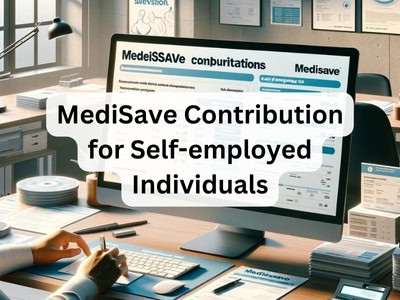This post is also available in:
简体中文 (Chinese (Simplified))
MediSave Contribution for Self-employed Individuals – What Is It Used for?

Why Does Self-employed Person Need to Contribute to MediSave?
Though a self-employed individual does not receive regular MediSave contributions from employers, the regular contribution will still make sure you could safeguard your retirement with sufficient MediSave savings for your healthcare needs.
You can leverage MediSave savings to:
- Cover healthcare expenses for yourself and your family.
- Make premium payment for MediShield Life or MediSave-approved private integrated plans.
- Earn higher savings interest – up to 6% interest per annum on your MediSave savings.
- Be entitled to tax relief of up to 37% of your annual NTI.
- Enjoy the Workfare Income Supplement (WIS) payouts of up to $2,400 annually (if eligible).
Compulsory MediSave Contributions
While CPF contributions are generally not compulsory for self-employed persons, MediSave contributions are. To be specific, you have to make compulsory contributions to your MediSave Account after you receive a Notice of Computation (“NOC”) of CPF Contributions from IRAS if:
- You are self-employed;
- You are a Singaporean or Permanent Resident; and
- Your Net Trade Income (NTI) is above $6,000.
Note: gross trade income – all allowable business expenses, capital allowances and trade losses = Net Trade Income (NTI)
In other words, all self-employed individuals with an annual NTI above $6,000 are compulsory to contribute to Medisave.
Amount of Compulsory MediSave Contributions
The annual contribution of MediSave amount is actually based on your:
- age;
- income level; and
- NTI for the previous year.
You can always refer to the MediSave Contribution Rates for Self-Employed Persons to check the contribution rates or utilise the Self-Employed MediSave Contribution Calculator to do the math – calculate the contribution amount of MediSave.
When to Contribute to the MediSave Account?
The IRAS will issue a ‘Notice of Computation’ (NOC) stating your actual MediSave payable to you after the assessment of the actual NTI for the year.
In the case the amount you need to pay exceeds what you have already contributed, you can pay the remaining amount in a 30-day window from the date of the NOC. If the amount contributed has exceeded your actual payable amount, the excess contributions will be brought forward to offset against your future MediSave payable.
In the event IRAS does not issue you with an income tax return filing package for the year, you can opt to declare your actual income by using Form IRAS 144 at any CPF Service Centre, SingPost branches or do it online with your SingPass. Please note that for income declared to the Board, you have to make the MediSave contributions based on the declared income by 31 May of the following year.
In summary, MediSave is the national medical savings scheme that helps Singaporean to set aside a portion of his or her salary into a MediSave account for future healthcare expenses. While you are the biggest winner under this medical savings scheme, you can also use the fund to pay for your family’s healthcare expenses.


